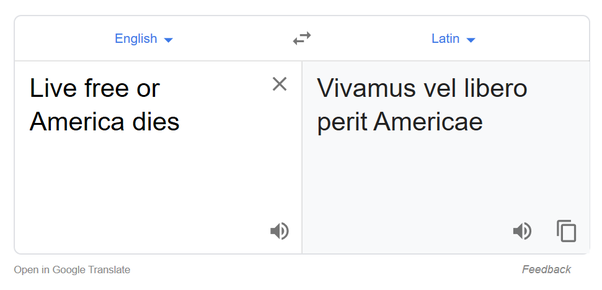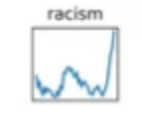Classical Chinese vulgarisms
[This is a guest post by Ken Hilton]
I came across this Facebook post and I thought it might be worth sharing on Language Log.
Read the rest of this entry »
Permalink Comments off
[This is a guest post by Ken Hilton]
I came across this Facebook post and I thought it might be worth sharing on Language Log.
Read the rest of this entry »
Permalink Comments off
Trump mispronounces Thailand as "Thighland" pic.twitter.com/PgTRnHpAA8
— The Recount (@therecount) August 6, 2020
Read the rest of this entry »
Sean Hannity's new book, Live Free or Die, was released a couple of days ago. The original cover featured a Latin motto, "Vivamus vel libero perit Americae", whose source was apparently Google Translate's version of "Live Free or America Dies":

As Spencer Alexander McDaniel observed, this is gobbledygook — or perhaps we should say "googledygook".
The title of McDaniel's post ("Sean Hannity does not know Latin") is unfair, though probably true, since the cover design was most likely created by the publisher. But a better observation might have been that Google Translate doesn't know Latin. Of course modern machine translation systems don't really "know" any languages, but have just memorized patterns of contextual correspondences. When the available training data is merely a few million words, as in the case of Latin, the results are often bad, as here.
Read the rest of this entry »
Annie Gottlieb asks:
Read the rest of this entry »
There's a Reddit page with this title: "Fully anglicised Japan, based off actual etymologies, rendered into plausible English". Feast your eyes:

(source)
Read the rest of this entry »
The title and the following observations come from Rebecca Hamilton:
I was reading Patrick Leigh Fermor's Between the Woods and the Water: on Foot to Constantinople, as I convalesce from COVID-19 (I've had a hard time of it), and I stumbled upon an aside he made about the French "hongre," meaning "gelding," as does the German "wallach." He made this comment – without further explication – in the context of a discussion of the ethnographic roots of Hungarians, Wallachians, and Rumanians (in particular, the latter as being descendants of Roman occupation, if not Romans themselves). What all this means, I cannot say. It seemed like a topic you would know something about. Because I am confined to bed for the moment, if you could be so kind as to forward me some reading material, I would be very grateful. Also, anything about "Wales" or "Welsh" sharing etymological roots with "Wallach," and how "wether" fits into all this would be great.
Read the rest of this entry »
[Update — apparently the data for the graphs presented by Sabeti and Miller came originally (without attribution) from work by David Rozado, who has provided useful information about his sources and methods. I therefore withdraw the suggestion that the counts were wrong, pending further study, though I am still not persuaded by the arguments that Sabeti and Miller used their version of his graphs to make.]
This is the subgraph for "racism" from the display originally presented in John F Miller's 2019 tweet, reproduced a few days ago by Arram Sabeti, and allegedly representing "New York Times Word Usage Frequency (1970 to 2018)":

Earlier today ("Sabeti on NYT bias"), I lodged some objections to Miller's graphs, especially the way that the y-axis scaling misrepresents the relative frequency of the various words and phrases covered. But after looking into things a little further, I find that it's not just a scaling problem — the underlying number sequences in Miller's graphs are substantially different from what I find in a search of the NYT archive, at least in the cases that I've checked. I don't know whether this is because of some issue with Miller's numbers, or with the counts from the NYT archive, or what. But for whatever reason, Miller's numbers are (in all cases where I've checked) seriously at variance with the results of NYT archive search.
And the differences make a difference — Miller's tendentious conclusion that "social liberal media and academia are wilfully gaslighting people" is even less well supported by the Archive's numbers than it was by the original misleadingly-scaled graphs.
Read the rest of this entry »
Barbara Partee asked me to comment on this thread by Arram Sabeti — crucial bit here:
2/ The data makes it plain that the NYT has abandoned its commitment to nonpartisan reporting. When the internet threatened their business they made a devil’s bargain to amplify outrage and us-vs-them psychology. Racism wasn't a new problem in 2014 but their stock being down was. pic.twitter.com/R7s7E7Mc4H
— Arram Sabeti (@arram) July 28, 2020
Read the rest of this entry »
This is the logo of Legco, the Legislative Council of Hong Kong:
It is a stylization of the "lap6 立" ("set up; erect; establish; enact") of:
Hoeng1gong2 dak6bit6 hang4zing3 keoi1 lap6faat3 wui6 (Jyutping)
Hēunggóng dahkbiht hàhngjing kēui laahpfaat wúih (Yale)
Xiānggǎng tèbié xíngzhèng qū lìfǎ huì (Hanyu pinyin)
香港特別行政區立法會
now written in PRC simplified characters as
香港特别行政区立法会
"Legislative Council of the Hong Kong Special Administrative Region"
or, for short:
Laap6faat3 wui5 (Jyutping)
Laahp faat wúih (Yale)
Lìfǎ Huì (Hanyu pinyin)
立法會
now written in PRC simplified characters as
立法会
"Legislative Council"
Read the rest of this entry »
In a statement on 7/29, Kevin McCarthy apparently meant to say "Congressman Gohmert" but what comes out is "Congressman Covid":
Kevin McCarthy accidentally calls Louie Gohmert "Congressman COVID" pic.twitter.com/UcQcvHtEU9
— The Recount (@therecount) July 29, 2020
Read the rest of this entry »
Permalink Comments off
What's your instinct? How many syllables do you think there are in the following words?
kawaii かわいい (Japanese for "cute")
Kawai カワイ (the Japanese piano manufacturer)
Kauaʻi (name of one of the Hawaiian islands)
In English, it's our habit to treat diphthongs consisting of two vowels as one syllable, but that's not the way they do it in Japanese, which has no diphthongs.
Read the rest of this entry »